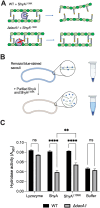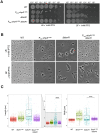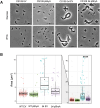Genetic interaction mapping reveals functional relationships between peptidoglycan endopeptidases and carboxypeptidases
- PMID: 38598601
- PMCID: PMC11034669
- DOI: 10.1371/journal.pgen.1011234
Genetic interaction mapping reveals functional relationships between peptidoglycan endopeptidases and carboxypeptidases
Abstract
Peptidoglycan (PG) is the main component of the bacterial cell wall; it maintains cell shape while protecting the cell from internal osmotic pressure and external environmental challenges. PG synthesis is essential for bacterial growth and survival, and a series of PG modifications are required to allow expansion of the sacculus. Endopeptidases (EPs), for example, cleave the crosslinks between adjacent PG strands to allow the incorporation of newly synthesized PG. EPs are collectively essential for bacterial growth and must likely be carefully regulated to prevent sacculus degradation and cell death. However, EP regulation mechanisms are poorly understood. Here, we used TnSeq to uncover novel EP regulators in Vibrio cholerae. This screen revealed that the carboxypeptidase DacA1 (PBP5) alleviates EP toxicity. dacA1 is essential for viability on LB medium, and this essentiality was suppressed by EP overexpression, revealing that EP toxicity both mitigates, and is mitigated by, a defect in dacA1. A subsequent suppressor screen to restore viability of ΔdacA1 in LB medium identified hypomorphic mutants in the PG synthesis pathway, as well as mutations that promote EP activation. Our data thus reveal a more complex role of DacA1 in maintaining PG homeostasis than previously assumed.
Copyright: © 2024 Alvarado Obando et al. This is an open access article distributed under the terms of the Creative Commons Attribution License, which permits unrestricted use, distribution, and reproduction in any medium, provided the original author and source are credited.
Conflict of interest statement
The authors have declared that no competing interests exist.
Figures








Similar articles
-
Novel role for peptidoglycan carboxypeptidases in maintaining the balance between bacterial cell wall synthesis and degradation.bioRxiv [Preprint]. 2023 Jul 12:2023.07.12.548665. doi: 10.1101/2023.07.12.548665. bioRxiv. 2023. PMID: 37503280 Free PMC article. Preprint.
-
Class A Penicillin-Binding Protein-Mediated Cell Wall Synthesis Promotes Structural Integrity during Peptidoglycan Endopeptidase Insufficiency in Vibrio cholerae.mBio. 2021 Apr 6;12(2):e03596-20. doi: 10.1128/mBio.03596-20. mBio. 2021. PMID: 33824203 Free PMC article.
-
Endopeptidase Regulation as a Novel Function of the Zur-Dependent Zinc Starvation Response.mBio. 2019 Feb 19;10(1):e02620-18. doi: 10.1128/mBio.02620-18. mBio. 2019. PMID: 30782657 Free PMC article.
-
Regulation of bacterial cell wall growth.FEBS J. 2017 Mar;284(6):851-867. doi: 10.1111/febs.13959. Epub 2016 Nov 23. FEBS J. 2017. PMID: 27862967 Review.
-
Interaction of penicillin with the bacterial cell: penicillin-binding proteins and penicillin-sensitive enzymes.Bacteriol Rev. 1974 Sep;38(3):291-335. doi: 10.1128/br.38.3.291-335.1974. Bacteriol Rev. 1974. PMID: 4608953 Free PMC article. Review. No abstract available.
Cited by
-
Sugar phosphate-mediated inhibition of peptidoglycan precursor synthesis.bioRxiv [Preprint]. 2024 Nov 14:2024.11.13.623475. doi: 10.1101/2024.11.13.623475. bioRxiv. 2024. Update in: mBio. 2025 Aug 13;16(8):e0172925. doi: 10.1128/mbio.01729-25. PMID: 39605520 Free PMC article. Updated. Preprint.
-
Bacterial peptidoglycan as a living polymer.Curr Opin Chem Biol. 2025 Feb;84:102562. doi: 10.1016/j.cbpa.2024.102562. Epub 2024 Dec 18. Curr Opin Chem Biol. 2025. PMID: 39700530 Review.
-
Sugar phosphate-mediated inhibition of peptidoglycan precursor synthesis.mBio. 2025 Aug 13;16(8):e0172925. doi: 10.1128/mbio.01729-25. Epub 2025 Jul 28. mBio. 2025. PMID: 40719473 Free PMC article.
-
The interplay between Acinetobacter baumannii ZigA and SltB promotes zinc homeostasis and cell envelope integrity.Infect Immun. 2025 Feb 18;93(2):e0042224. doi: 10.1128/iai.00422-24. Epub 2025 Jan 23. Infect Immun. 2025. PMID: 39846731 Free PMC article.
References
-
- Mett H, Bracha R, Mirelman D. Soluble nascent peptidoglycan in growing Escherichia coli cells. J Biol Chem. 1980. Oct 25;255(20):9884–90. - PubMed
Publication types
MeSH terms
Substances
Grants and funding
LinkOut - more resources
Full Text Sources

